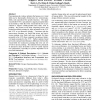Free Online Productivity Tools
i2Speak
i2Symbol
i2OCR
iTex2Img
iWeb2Print
iWeb2Shot
i2Type
iPdf2Split
iPdf2Merge
i2Bopomofo
i2Arabic
i2Style
i2Image
i2PDF
iLatex2Rtf
Sci2ools
CHI
2004
ACM
2004
ACM
Mouse and touchscreen selection in the upper and lower visual fields
Neuroanatomical evidence indicates the human eye's visual field can be functionally divided into two vertical hemifields, each specialized for specific functions. The upper visual field (UVF) is specialized to support perceptual tasks in the distance, while the lower visual field (LVF) is specialized to support visually-guided motor tasks, such as pointing. We present a user study comparing mouse- and touchscreen-based pointing for items presented in the UVF and LVF on an interactive display. Consistent with the neuroscience literature, we found that mouse and touchscreen pointing were faster and more accurate for items presented in the LVF when compared to pointing at identical targets presented in the UVF. Further analysis found previously unreported performance differences between the visual fields for touchscreen pointing that were not observed for mouse pointing. This indicates that a placement of interactive items favorable to the LVF yields superior user performance, espec...
CHI 2004 | Human Computer Interaction | Mouse Pointing | Touchscreen Pointing | Touchscreen-based Pointing |
| Added | 01 Dec 2009 |
| Updated | 01 Dec 2009 |
| Type | Conference |
| Year | 2004 |
| Where | CHI |
| Authors | Barry A. Po, Brian D. Fisher, Kellogg S. Booth |
Comments (0)

